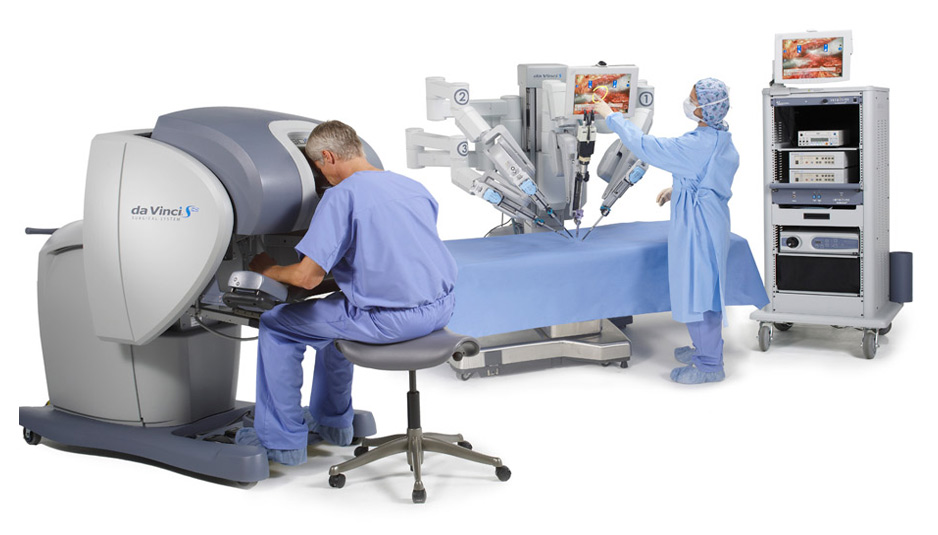Da Vinci, Leonardo: minimally invasive surgical robot
Da Vinci bypasses conventional surgery, allowing the surgeon to perform complex operations without subjecting the patient to aggressive procedures

humanitas.it
Siena Scotte Hospital performed the first surgery with contemporary thyroid-thymus removal, through robotics with minimally invasive surgery procedure. The patient suffers from two different conditions, one dependent on the thymus and another at the expense of the thyroid, was treated with a single operation, which lasted about 6 hours, practicing only three holes of a few millimeters, thanks to robot Da Vinci: result of a collaborative work between the UOC team of thoracic surgery of the university Hospital of Siena, directed by Giuseppe Gotti and Pierguido Ciabatti otolaryngology and director of the hospital in Arezzo. The project, announced the doctors, “was a complete success and the patient was discharged after four days.”
What is special and innovative about Da Vinci robotic surgical system? What is the turning point marked by Leonardo?
The robotic system Da Vinci – SI HD IS3000 – is the most advanced platform on the market for minimally invasive surgery. Leveraging the integration of a high-definition 3D vision by EndoWrist and intuitive instrument control, bypasses the limitations of conventional surgery, allowing the surgeon to perform complex operations without subjecting the patient to aggressive procedures. The da Vinci system uses three main components: surgical console, patient cart and vision cart.
SURGICAL CONSOLE
humanitas.itControl center of the da Vinci system. Through the console, positioned outside the sterile field, The surgeon controls the endoscope 3D and tools EndoWrist, by two manipulators, said the master, and pedals. In stereo viewer, the tips of the instruments are aligned with the surgeon’s hands, grasping manipulators, it simulates the natural alignment of the eyes, hands and instruments typical of “open surgery”, while using a minimally invasive procedure. The scale dimensioning of the movements and reduction of tremor provide additional control, which minimizes the impact of physiological tremor of the hands of the surgeon or involuntary movements.
humanitas.itThe surgical console operator also has the option to switch between full-screen view of a multi-mode images – TilePro display – showing the 3D image of the surgical field in conjunction with two other pictures – ultrasound and ECG – provides inputs auxiliary.
PATIENT CART
humanitas.itComponent operating the da Vinci system, whose main function is to support the “arms tool” and “arm camera.” Leonardo makes use of a technology in the remote center, that is, of a fixed point in space around which move the arms of the carriage patient. This technology allows the Da Vinci to manipulate the instruments and endoscopes within the surgical site while minimizing the force on the body wall of the patient. Guaranteeing extreme safety for the patient.
VISION CART
humanitas.itCentral processing unit and video equipment. It includes a 24-inch touchscreen and adjustable shelves for optional ancillary surgical equipment such as electrosurgical units and insufflators.
The da Vinci system uses a high-definition video, comprising:
- Core: core of the system to which you connect auxiliary equipment and AV (audio / video).
- Illuminator: The light is delivered via the endoscope light cable to optical fiber and projected on the surgical site.
- Endoscopes: Leonardo uses 3D endoscopes of 12 mm or 8.5 mm with slanted or straight.
- Control unit camera (CCU) controls the acquisition and processing of the image from the camera.
- Touch Screen: used to control the system settings and the image display surgery.
- portabombole CO2: adjustable cylinders of different sizes.Let particular attention from the point of safety view, to make even more clear the turning point marked by Leonardo.
PATIENT SAFETY
Performing more than one million automatic security controls within the second, the system ensures maximum safety and reliability during operation. An intelligent mechanism guarantees an efficient and safe replacement of the tools during surgery. The large view gives providers an improved visualization of anatomy and tools with access to outlying areas. The audio-video feedback with audible and visual alarms keep the surgeon and the operating room staff updated on the status and functions of the system.
Also – last but not least for the most skeptical – the da Vinci system is constantly connected to the Ethernet network hospital through the “ Da Vinci On-Site”, which allows real-time diagnostics. This service allows you to get detailed reports on the state of the system, speeding remote diagnostics and troubleshooting.
humanitas.itBy Internet access Leonardo also makes use of a “Network Connect” which makes it possible to interact with the operating room by videoconference. There are in fact calendar of interventions in order to book the connection with the operating room of interest and follow the complete procedure in real time.
CLINICAL APPLICATIONS
Since its introduction on the market the Da Vinci Surgical System has been successfully used in thousands of procedures. Its safety, effectiveness and superiority are demonstrated in large clinical results. Da Vinci robotic surgery is applied to different types of specialties:
- General and Vascular Surgery
- Uro-Gynecological Surgery
- Thoracic Surgery
- Cardiovascular
- Pediatric Surgery
- Otolaryngology
The da Vinci robotic system offers several advantages over “open surgery”, such as:
ADVANTAGES FOR THE PATIENT
- Small incisions with mild bleeding
- Less need for transfusion
- Less postoperative pain
- Reduction in hospitalization time
- Reduced recovery time
- Shooting faster than normal activityIn mid-2013 2,800 systems are installed worldwide Da Vinci. In the image the distribution of installations on the continents.
humanitas.it
Italy has, to date, 64 installations. Following is a breakdown of Italian centers that are running a Da Vinci Surgical System by region.
